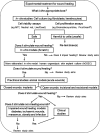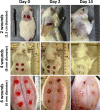Experimental models and methods for cutaneous wound healing assessment
- PMID: 32227524
- PMCID: PMC7306904
- DOI: 10.1111/iep.12346
Experimental models and methods for cutaneous wound healing assessment
Abstract
Wound healing studies are intricate, mainly because of the multifaceted nature of the wound environment and the complexity of the healing process, which integrates a variety of cells and repair phases, including inflammation, proliferation, reepithelialization and remodelling. There are a variety of possible preclinical models, such as in mice, rabbits and pigs, which can be used to mimic acute or impaired for example, diabetic and nutrition-related wounds. These can be induced by many different techniques, with excision or incision being the most common. After determining a suitable model for a study, investigators need to select appropriate and reproducible methods that will allow the monitoring of the wound progression over time. The assessment can be performed by non-invasive protocols such as wound tracing, photographic documentation (including image analysis), biophysical techniques and/or by invasive protocols that will require wound biopsies. In this article, we provide an overview of some of the most often needed and used: (a) preclinical/animal models including incisional, excisional, burn and impaired wounds; (b) methods to evaluate the healing progression such as wound healing rate, wound analysis by image, biophysical assessment, histopathological, immunological and biochemical assays. The aim is to help researchers during the design and execution of their wound healing studies.
Keywords: cutaneous wound models; experimental animal models; in vivo models; skin ulcer; tissue repair; wound healing.
© 2020 Company of the International Journal of Experimental Pathology (CIJEP).
Conflict of interest statement
The authors have no conflict of interest.
Figures



Similar articles
-
Effect of herbal mixture composed of Alchemilla vulgaris and Mimosa on wound healing process.Biomed Pharmacother. 2018 Oct;106:326-332. doi: 10.1016/j.biopha.2018.06.141. Epub 2018 Jul 11. Biomed Pharmacother. 2018. PMID: 29966977
-
Improvement of skin wound healing in diabetic mice by kinin B2 receptor blockade.Clin Sci (Lond). 2016 Jan;130(1):45-56. doi: 10.1042/CS20150295. Epub 2015 Oct 6. Clin Sci (Lond). 2016. PMID: 26443866
-
Spatiotemporal single-cell roadmap of human skin wound healing.Cell Stem Cell. 2025 Mar 6;32(3):479-498.e8. doi: 10.1016/j.stem.2024.11.013. Epub 2024 Dec 26. Cell Stem Cell. 2025. PMID: 39729995
-
MiR equal than others: MicroRNA enhancement for cutaneous wound healing.J Cell Physiol. 2021 Dec;236(12):8050-8059. doi: 10.1002/jcp.30485. Epub 2021 Jun 23. J Cell Physiol. 2021. PMID: 34160067 Review.
-
Regulation of the Wound Healing Response during Aging.J Invest Dermatol. 2021 Apr;141(4S):1063-1070. doi: 10.1016/j.jid.2020.11.014. Epub 2021 Feb 6. J Invest Dermatol. 2021. PMID: 33558058 Review.
Cited by
-
Tryptophan intrinsic fluorescence from wound healing correlates with re-epithelialization in a rabbit model.Skin Res Technol. 2024 Jul;30(7):e13834. doi: 10.1111/srt.13834. Skin Res Technol. 2024. PMID: 38923076 Free PMC article.
-
Progress in the application of artificial intelligence in skin wound assessment and prediction of healing time.Am J Transl Res. 2024 Jul 15;16(7):2765-2776. doi: 10.62347/MYHE3488. eCollection 2024. Am J Transl Res. 2024. PMID: 39114681 Free PMC article. Review.
-
Effects of Superficial Scratching and Engineered Nanomaterials on Skin Gene Profiles and Microbiota in SKH-1 Mice.Int J Mol Sci. 2023 Oct 26;24(21):15629. doi: 10.3390/ijms242115629. Int J Mol Sci. 2023. PMID: 37958613 Free PMC article.
-
The effects of ketoprofen and meloxicam on oxidative stress through the glutathione pathway after ketamine-xylazine anesthesia and ulcer induction in rats: A comparative study.Vet Anim Sci. 2024 Jul 14;25:100377. doi: 10.1016/j.vas.2024.100377. eCollection 2024 Sep. Vet Anim Sci. 2024. PMID: 39130674 Free PMC article.
-
Accelerating cutaneous healing in a rodent model of type II diabetes utilizing non-invasive focused ultrasound targeted at the spleen.Front Neurosci. 2022 Nov 17;16:1039960. doi: 10.3389/fnins.2022.1039960. eCollection 2022. Front Neurosci. 2022. PMID: 36478877 Free PMC article.
References
-
- Mulkalwar S, Behera L, Golande P, Manjare R, Patil H. Evaluation of wound healing activity of topical phenytoin in an excision wound model in rats. Int J Basic Clin Pharmacol. 2015;4:139‐143.
-
- Shrimanker M, Patel N, Modi H, Dave R. A review: screening models for wound healing activity in animals. Am J Pharm Tech Res. 2013;3:237‐251.
-
- Velnar T, Bailey T, Smrkolj V. The wound healing process: an overview of the cellular and molecular mechanisms. J Int Med Res. 2009;37:1528‐1542. - PubMed
-
- Koschwanez HE, Broadbent E. The use of wound healing assessment methods in psychological studies: a review and recommendations. Br J Health Psychol. 2011;16:1‐32. - PubMed
-
- Mendonça A, Ferreira A, Barbieri C, Thomazine J, Mazzer N. Efeitos do ultra‐som pulsado de baixa intensidade sobre a cicatrização por segunda intenção de lesões cutâneas totais em ratos. Acta Ortop Bras. 2006;14:152‐157.
Publication types
MeSH terms
LinkOut - more resources
Full Text Sources
Other Literature Sources

